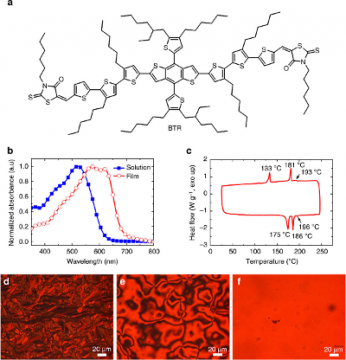Improved Solar Panels and Printed Electronics on the Horizon With New Material Discovery
Published today in Nature Communications, University of Melbourne researchers say their discovery of the highly sought-after ‘nematic liquid crystals’ can now lead to vastly improved organic solar cell performance.
Lead author Dr David Jones of the University’s School of Chemistry and Bio 21 Institute, said these cells will be easier to manufacture, with the new crystals now able to work in cells that are double in thickness on the previous limit of 200 nanometers.
“We have improved the performance of this type of solar cell from around 8 per cent efficient to 9.3 per cent, finally approaching the international benchmark of 10 per cent.”
(a) Chemical structure of BTR. (b) Normalized UV–vis absorption spectra of BTR in chloroform (5 mg ml−1) and in a spin-cast film. (c) DSC thermogram of BTR in nitrogen at a ramp rate of 10 °C min−1. The lower trace is from the heating cycle and upper trace from the cooling cycle. (d) BTR thin film sandwiched in between two glass slides observed under a polarized optical microscope (POM) at a stage temperature of 185 °C. (e) The POM image of the same BTR thin film at the same settings when the stage temperature rises to 195 °C. (f) The POM image taken at a stage temperature of 197 °C.
It means that consumers can look forward to more competitive pricing in the solar energy sector, and according to Dr Jones, the discovery is a shot-in-the-arm for the whole organic materials sector. “The discovery is a step forward for the wider commercialization of printed organic solar cells. But more than this, could aid in the development of new materials with improved performance such as LCD screens.”
Uptake of the current generation of organic solar cells has lagged behind more widespread silicon-based models, due to their comparative lack of performance even with a simplified construction via large printers.
This is despite the organic models providing an unparalleled degree of versatility in how they are used; they can be shaped to fit nearly any surface area, as opposed to the traditional ‘grid’ formation of silicon-based cells.
“It had been theorized that a certain group of nematic liquid crystals would provide excellent electronic properties – as well as being printable – and therefore they had been sought for a long time,” said Dr Jones. “With this research, we have shown for the first time these high performing materials.”
“We’ve seen recently at the annual Consumer Electronics Show (CES) in Las Vegas that printable electronics have an exciting future, as parts of phones and even cars. This discovery could help improve the performance of these solar cells, and lead to even more innovation in the coming years,” concluded Dr Jones.
The research was conducted with international researchers in Singapore, China and Germany, and received funding from the Victorian Organic Solar Cell Consortium, and the Australian Centre for Advanced Photovoltaics.
![]() Tags: Australia, Nature Communications, research, Solar Research, University of Melbourne
Tags: Australia, Nature Communications, research, Solar Research, University of Melbourne


